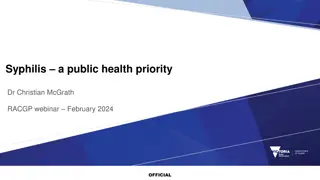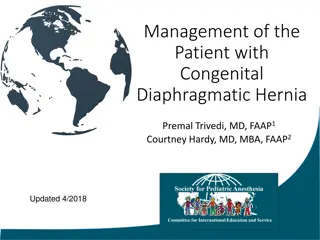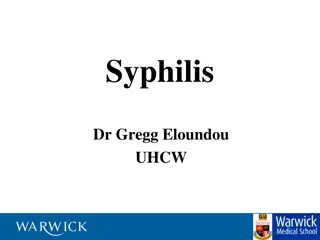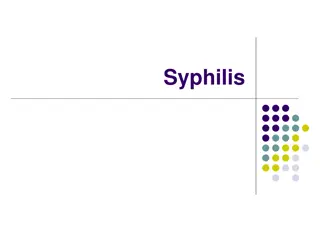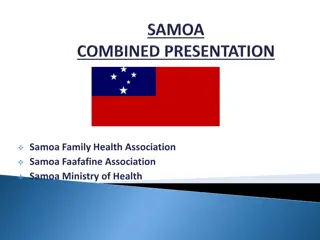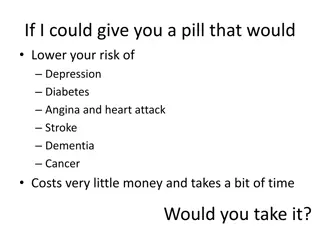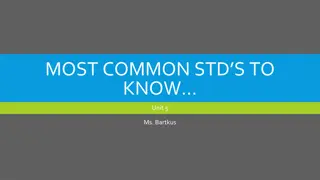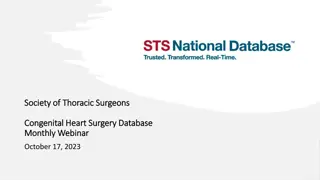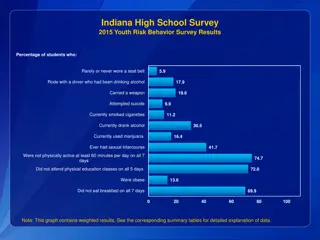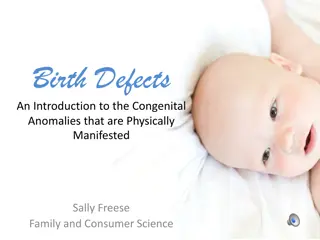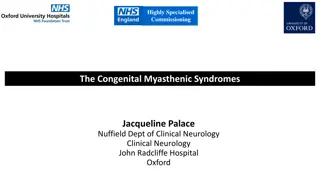Understanding the Impact of Congenital Syphilis in Indiana
Social Vulnerability in Congenital Syphilis cases among mothers in Indiana is a pressing issue. Despite being preventable, the rise in cases signals a failure in detection and care systems. The trend of increasing cases is associated with a rise in infectious syphilis among women. This qualitative assessment highlights socioeconomic and geographic disparities, late prenatal care initiation, missed screening opportunities, and the need for improved medical management.
Download Presentation

Please find below an Image/Link to download the presentation.
The content on the website is provided AS IS for your information and personal use only. It may not be sold, licensed, or shared on other websites without obtaining consent from the author. Download presentation by click this link. If you encounter any issues during the download, it is possible that the publisher has removed the file from their server.
E N D
Presentation Transcript
Agenda Introduction of presenters Article background, methods, and results Discussion Q&A 3
Objectives Describe the major sections of the journal article that is presented (i.e., background, methods, and results). Identify the journal article s implications for your state s STD program. 4
Introduction Social Vulnerability in Congenital Syphilis Case Mothers: Qualitative Assessment of Cases in Indiana, 2014 to 2016. Amara Ross STD Epidemiologist Dawne DiOrio Public Health Advisor 5
Introduction Congenital syphilis (CS) is the transmission of a syphilis infection from an untreated pregnant woman to the fetus Preventable with early detection and treatment Occurrence signals a failure of both syphilis detection mechanisms and prenatal care systems Following a five year decrease (2008-2012), cases of congenital syphilis have risen each year since 2013 nationwide 6
Congenital Syphilis Trends US & IN Congenital Syphilis Reported Cases by Year of Birth and Rates of Reported Cases of Primary and Secondary Syphilis Among Women Aged 15-44 Years, United States, 2008-2017 (Figure 49)1 The recent increases in congenital syphilis cases have been associated with increase in infectious syphilis (primary and secondary) among women1 1. Centers for Disease Control and Prevention. Sexually Transmitted Disease Surveillance 2017. Atlanta: U.S. Department of Health and Human Services; 2018. 7
Congenital Syphilis Trends US & IN Reported Cases of Primary and Secondary Syphilis Among Women and Rates of Congenital Syphilis, Indiana, 2012 - 2016 40 10.0 9.0 35 8.0 30 7.0 Number of Cases 25 6.0 Case Rate 20 5.0 4.0 15 3.0 10 2.0 5 1.0 0 0.0 2012 2013 2014 2015 2016 P&S Cases CS Rate 8 8
What is known Socioeconomic and geographic differences Late initiation or lack of prenatal care (PNC) Missed opportunities by health care provider for screening or treatment (i.e., incorrect medical management) Nearly all US studies to date examine reasons for CS on large scale data (eg all birth certificates; multi-year hospital records) 9
What is known Lack of prenatal care Late initiation of prenatal care Lack of health insurance Late enrollment in Medicaid No transportation No child care Food insecurity Insecure housing Violence Poverty Low educational levels Social isolation Lack of control in one s life Unplanned/unwanted pregnancy Psychological stresses Other risky lifestyle choices Incarceration Drug use Mental health Substance abuse Cost of copays 10
Research Methods Did case adhere to established CDC and ISDH screening and treatment guidelines? Coding for common themes Objectives DIS interview notes from case mother syphilis investigations Maternal records with information regarding pregnancy history and prenatal care Case Reviews Demographics, syphilis diagnosis, prenatal care (PNC), HIV status, housing stability, domestic violence, incarceration, drug use, health insurance, syphilis diagnosis of male syphilis partner Coded Factors 11
Results 12
The 23 CS Cases: Demographic and Disease-related information 4% Maternal Syphilis Cases # Cases Syphilis less than 1 year s duration 14 48% Syphilis greater than 1 year duration 11 White 48% Male sex partner also had syphilis 7 Negative syphilis test in early pregnancy 7 African- American Multiracial Mother diagnosed with syphilis twice during pregnancy 2 HIV-positive mother 1 Note: Duration rows total 25 because two cases had syphilis twice Average age: 26.1 years Most had health insurance (91%) 13 13
Prenatal Care Among Case Mothers Prenatal Care (PNC) Among Case Mothers # Cases 3 stillbirths 1 had no PNC 2 had inadequate PNC Mothers with no PNC 8 Mothers with PNC 15 Healthcare provider followed screening and treatment recommendations 15 First visit in 1st Trimester 12 PNC inadequate 10 Note: Number of visits ranged 1 33, Median= 4 visits 14 14
The research question Since we learned that no CS cases in our group could be attributed to health care provider behavior, what factors present in the mother s life seemed to be associated? Important to note this study does not allow us to attribute causality 15
Themes identified from document review Social vulnerability Lack of engagement in health care Male sex partner risk Important to note that most women experienced all three at once 16
Social Vulnerability Incarceration of mother or male partner (current or within last 2 years) Drug Use and domestic violence (underreported) Chaotic living conditions including homeless Medicaid proxy for low income No job or bad job 17
Social Vulnerability (cont.) 39% were homeless or had an unstable housing situation 35% had history of incarceration in the last two years (case mother only, male sex partner only, both case mother and male sex partner) 9% admitted drug use within the last year 18
Lack of engagement in health care Difficulty following through when tests were ordered (at off-site lab from PNC provider office) Difficulty obtaining treatment when syphilis diagnosed after many attempts by doctor and the STD DIS Reason not specified except for: One mother stated she was unable to take time off from her minimum-wage, fast food job for lab work and prenatal appointments because she would not be paid (example of bad job influence) 19
Male partner risk Nearly one-third of the mothers ONLY risk for contracting syphilis was her primary (steady/only named) sex partner Seven of these primary male partners were newly identified as syphilis cases as a result of the woman s diagnosis Two of the steady male partners refused to be tested or receive prophylactic treatment despite health care provider and DIS intervention Two case mothers were reinfected with syphilis during the same pregnancy by their steady male partner, despite intensive DIS intervention 20
Congenital Syphilis is 100% preventable But many factors have to be in place to ensure the case is averted, such as: Woman tested for syphilis (if pregnant) Woman tested for pregnancy (if she has syphilis) Adequate treatment if positive test 1 shot?, 3 shots? Treatment must be given 30 days or more before birth For any of these to occur, women must have knowledge of syphilis and pregnancy, should have an accurate self- perception of risk, should have personal motivation for health care, and capacity to carry out intentions At each of these steps, social or structural challenges and barriers may present themselves 21
CS is preventable, but.. The woman needs to have structural supports in place that enable her to get care such as: health insurance or a payment source, access to a medical provider and the ability to get there (transportation, child care, time off work) Also requires the medical provider to do their part for timely and adequate testing, correct treatment based on syphilis stage And if late diagnosis, treatment may not be able to be given 30 days before delivery (preterm birth common in syphilis patients) 22
Two recent studies on CS Kidd, et al (2018) examined 2016 U.S. syphilis case reports and CS case reports for CS Prevention Cascade 75% of CS cases were averted through action by health care provider, pregnant woman, and public health Largest gaps in prevention services among CS moms: 1) at entry into PNC; and 2) between early testing and timely treatment 24
New studies (cont.) Sanderson Slutsker, et al examined NYC syphilis case reports and CS case reports 2010-2016 88% of CS cases averted through health care provider, pregnant woman, and public health action 31% of CS case moms did not get timely PNC 25
New studies (cont.) Of 69% with timely PNC 9% did not receive syphilis test until <45 d before delivery 47% became infected after neg. syphilis test Based on these recent studies, MOST syphilis cases in pregnant women do NOT result in a case of CS 26
What is known beyond CS Worldwide (OECD countries) and within the U.S. (state comparison), health issues are greatly impacted by the amount of social spending 20% increase in median social-to-health spending ratio = 85K fewer obese adults, eg Health spending in U.S. great variation by state (Indiana 49/50 per capita for PH funding) 27
Similar findings Sanderson Slutsker findings similar to ours Among CS case moms with PNC, identified substance abuse, mental health disorders, recent arrival to U.S., and lack of health insurance (24% of CS case moms) One mom neg test 2nd trimester, ED visit 3rd trimester with syphilis symptoms (no intervention), delivery test positive 28
Conclusion Preventing congenital syphilis in the U.S. may require a focus on both ameliorating the social vulnerabilities affecting pregnant women with syphilis, and traditional medical management. 29
How can findings be applied? STD Program Conduct similar CS case review to identify factors leading to cases in your state Have DIS collect supplemental information on pregnant syphilis interviews to aid understanding Identify males at risk for syphilis who have pregnant partners so they may be tested and treated before transmitting infection to the woman Explore syphilis testing in hospital emergency departments and urgent care centers for pregnant women not in PNC 30
How can findings be applied? LHD or community Strengthening links in the social and health safety net for vulnerable women so we may identify those who have discontinued prenatal care; fail to obtain syphilis testing or treatment; identify those who may benefit from supportive case management Identify which tangible (structural) services may be lacking for pregnant women in a community such as transportation, child care, availability of PNC providers especially those accepting Medicaid 31
How can findings be applied? Health care providers Identify males at risk for syphilis who have pregnant partners so they may be tested and treated before transmitting infection to the woman Consider using syphilis point-of-care tests to reduce likelihood of a woman not getting testing from an off-site laboratory due to cost, transportation, or scheduling 32
Additional references Variation In Health Outcomes: The Role Of Spending On Social Services, Public Health, And Health Care, 2000 09, Elizabeth Bradley et al, Health Affairs, Vol 35, No. 5, https://doi.org/10.1377/hlthaff.2015.0814 https://www.tfah.org/report-details/a-funding-crisis- for-public-health-and-safety-state-by-state-public- health-funding-and-key-health-facts-2017/ 33
Slutsker JS, Hennessy RR, Schillinger JA. Factors Contributing to Congenital Syphilis Cases New York City, 2010 2016. MMWR Morb Mortal Wkly Rep 2018;67:1088 1093. DOI: http://dx.doi.org/10.15585/mmwr.mm6739a3. Kidd S, Bowen V, Torrone, E, Bolan, G, Use of National Syphilis Surveillance Data to Develop a Congenital Syphilis Prevention Cascade and Estimate the Number of Potential Congenital Syphilis Cases Averted. Sex Trans Dis 2018;45 (9S) S23 DOI:10.1097/OLQ.0000000000000838 34
Group Discussion What strategies has your health department or organization employed to address congenital syphilis in your area? Any similar strategies as those listed previously? How has your health department or organization partnered with local agencies to address congenital syphilis and/or social vulnerability of mothers? What services already exist? What barriers have you faced with building partnerships? How have DIS in your area played a role in addressing these issues? 35
Additional questions? Dawne DiOrio DDiorio@isdh.IN.gov Amara Ross ARoss2@isdh.IN.gov Leandra Lacy llacy@ncsddc.org 36



